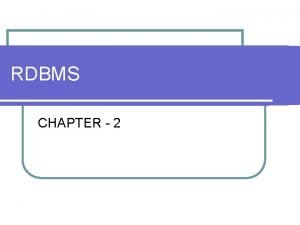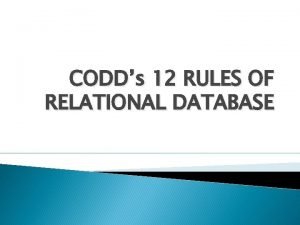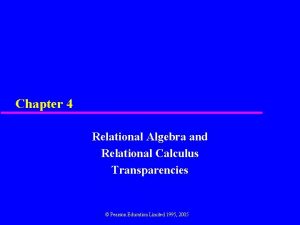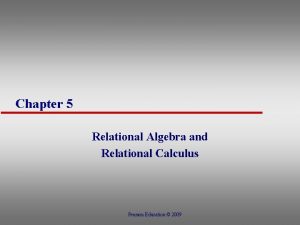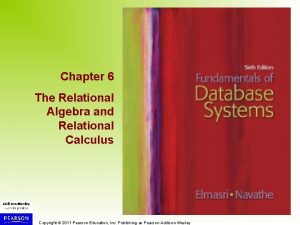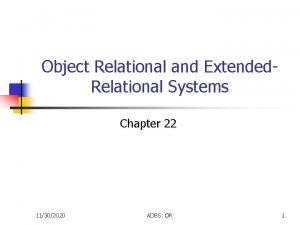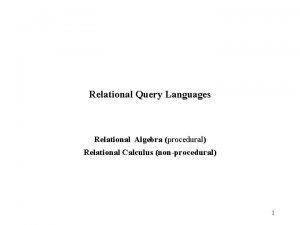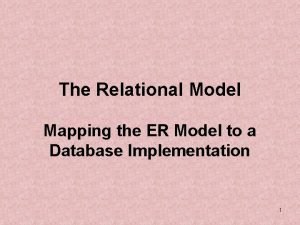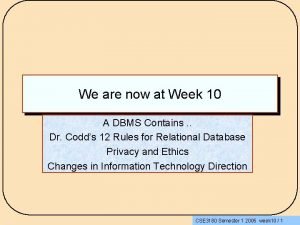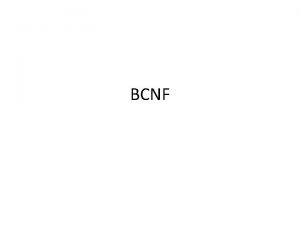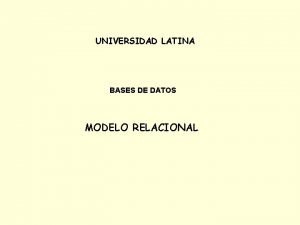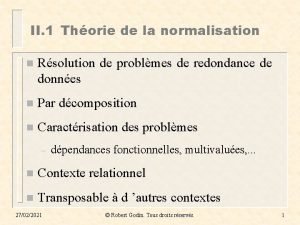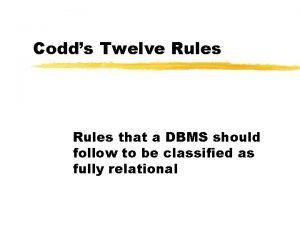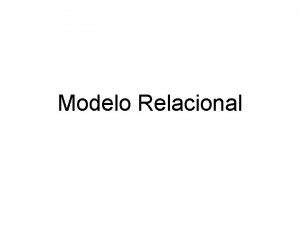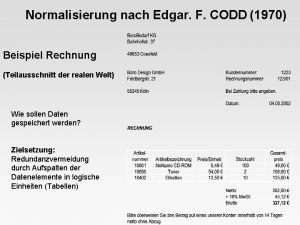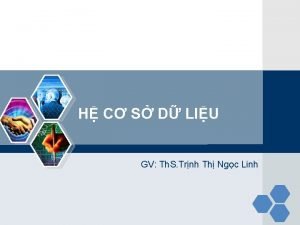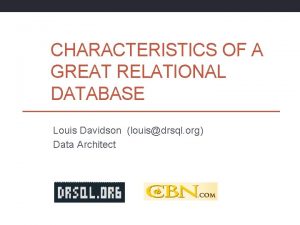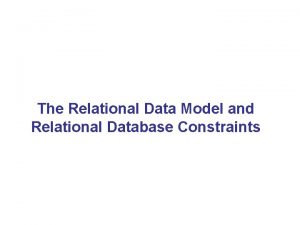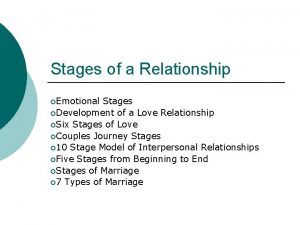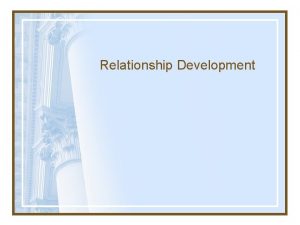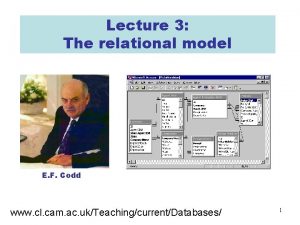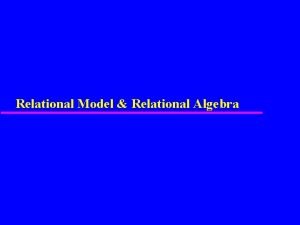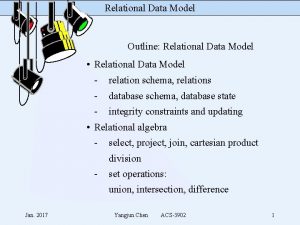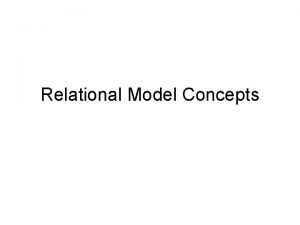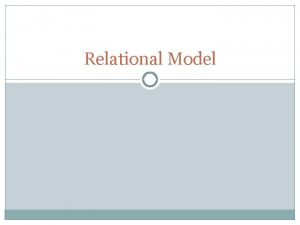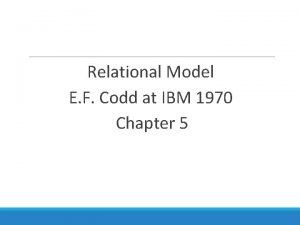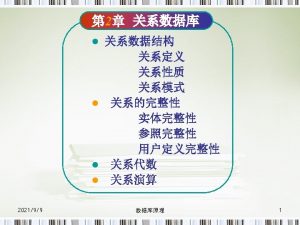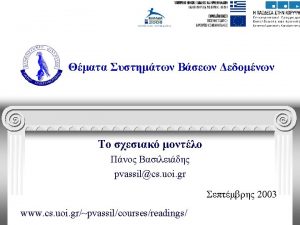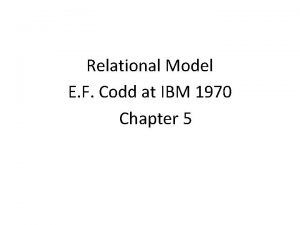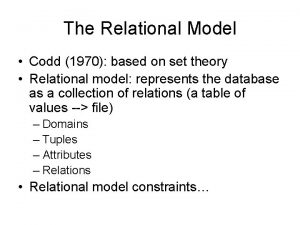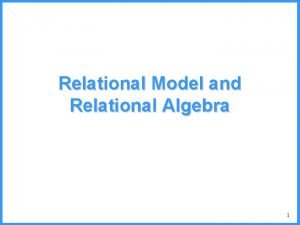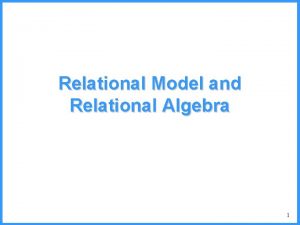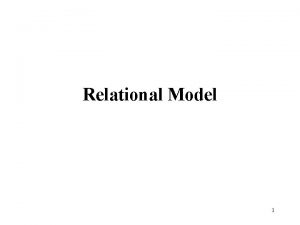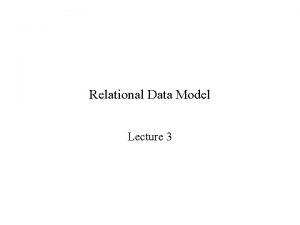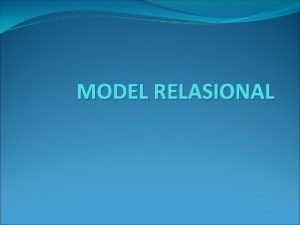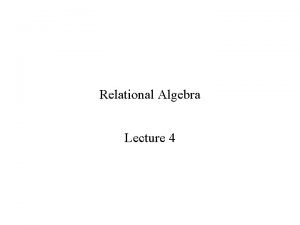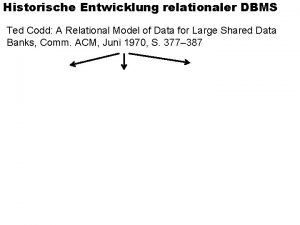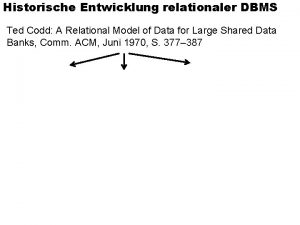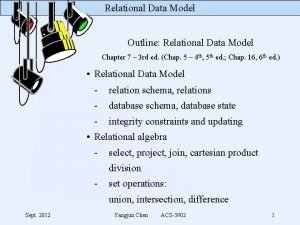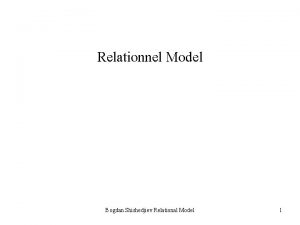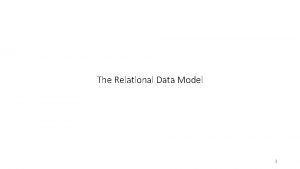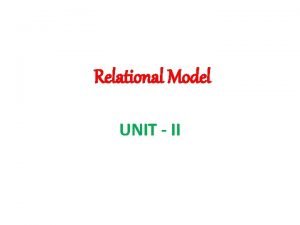Lecture 3 The relational model E F Codd

























- Slides: 25

Lecture 3: The relational model E. F. Codd www. cl. cam. ac. uk/Teaching/current/Databases/ 1

Today’s lecture • • What’s the relational model? What’s SQL? How do we create databases in SQL? How do we convert E/R models to a relational model? • How do we enforce real-life constraints in a relational database? 2

Why study the relational model? • It’s the dominant model in the marketplace – Vendors: Microsoft, Oracle, IBM, … • SQL is the industrial realisation of the relational model • SQL has been standardised (several times) • Most of the commercial systems have substantially extended the standard! 3

The relational model: Early history • Proposed by E. F. Codd (IBM San José) ~1970 – Prior to this the dominant model was the network model (CODASYL) • Mid 70’s: prototypes – Sequel at IBM San José – INGRES at UC Berkeley (M. Stonebraker) – PRTV at IBM UK • 1976 -: System R at IBM San José – Transactions (J. Gray et al. ) – Query optimiser (P. Selinger et al. ) – Extended -testing (Boeing et al. ) • 1978/9 -: CODD at Cambridge Computer Lab – Extended relational algebra query language (K. Moody) 4

The relational model: Basics • A relational database is a collection of relations • A relation consists of two parts: – Relation instance: a table, with columns and rows – Relation schema: Specifies the name of the relation, plus the name and type of each column • Can think of a relation instance as a set of 5 rows or tuples

Examples • Relation schema Students(sid: string, name: string, login: string, age: integer) Relation name Field name Domain • In general R(A 1: 1, …, An: n) 6

Examples Fields • Relation instance Field names Tuples login age sid name 1001 1002 Myleene MK Danny DF 23 22 1003 1004 1005 Noel NS Suzanne SS Johnny JS 21 20 23 7

Relational terminology • A domain is a set of values. All domains in a relation must be atomic (indivisible) • Given a relation R=R(A 1: 1, …, An: n), R is said to have arity (degree) n • Given a relation instance, its cardinality is the number of rows – For example, in Students, cardinality=5 (arity=4) 8

Relations and sets • A relation R=R(A 1: 1, …, An: n) can be defined more formally as R 1 n • Thus a relation is a set of tuples, so there is no ordering of the tuples in the table • Moreover, there are no duplicate rows in the table 9

Keys • Given a relation R=R(A 1: 1, …, An: n) a (candidate) key is a subset of fields K {A 1, …, An} that acts as a unique identifier for each tuple in the relation instance • We annotate the schema accordingly, e. g. R=R(A 1: 1, …, An: n) 10

SQL • SQL is the ubiquitous language for relational databases • Standardised by ANSI/ISO in 1992: SQL/92 • Part of SQL is a Data Definition Language (DDL) that supports the creation, deletion and modification of tables 11

Creating tables • The CREATE TABLE statement, e. g. CREATE TABLE Students (sid CHAR(20), name CHAR(20), login CHAR(10), age INTEGER); • Note that the domain of each field is specified and enforced by the DBMS 12

Removing and altering tables • We can delete both the schema information and all the tuples, e. g. DROP TABLE Students; • We can alter existing schemas, e. g. adding an extra field ALTER TABLE Students ADD COLUMN matric INTEGER; 13

Adding and deleting tuples • Can insert tuples into a table, e. g. INSERT INTO Students(sid, name, login, age) VALUES (“ 1006”, “Julia”, “jfg”, 21); • Can remove tuples satisfying certain conditions, e. g. DELETE FROM Students WHERE name=“Myleene”; 14

Querying relations • We can list the current contents of a table with a query SELECT * FROM Students; • We can add conditions to the query, e. g. SELECT * FROM Students S WHERE S. age=23; 15

From E/R diagrams to relations • The E/R model is convenient for representing the high-level database design • Given an E/R diagram there is a reasonably straightforward method to generate a relation schema that corresponds to the E/R design 16

Entity types to relations • A (strong) entity type maps to a relation schema in the obvious way, e. g. NI Name dob Employees is mapped to the relation schema Employees(NI: 1, Name: 2, dob: 3) 17

Relationship types to relations • Given a relationship type, we generate a relation schema with fields consisting of: – The keys of each associated entity type – Any associated relationship attributes 18

Example NI Name Employees dob M since Works_in dname DID N budget Departments is mapped to the relation schema: Works_in(NI: 1, DID: 2, since: 3) 19

Recursive relationship sets • Just pick appropriate field names! E. g. name NI dob Employees supervisor subordinate Reports-to is mapped to Reports_to(sup_NI: 1, sub_NI: 1) 20

Weak entity types • Given a weak entity type, W, we generate a relation schema with fields consisting of the attributes of W, and the primary key attributes of the owner entity type • For any relationship in which W appears we generate a relation schema which must take as the key for W all of its key attributes, including those from its owner set 21

Example Name NI Employees p. Name Cost 1 Policy N age Dependents is mapped to the following schema: Dependents(p. Name: 1, NI: 2, age: 3) Policy(p. Name: 1, NI: 2, Cost: 4) Alternatively: Policy(p. Name : 1, NI : 2, age : 3, Cost : 4) 22

ISA Hierarchies Name NI dob Employees rate hours Temp_Emp ISA Two choices: 1. 3 relations cid Contract_Emp (Employees, Temp_Emp and Contract_Emp) 2. 2 relations (Temp_Emp and Contract_Emp) 23

Other features • Other features can also be mapped from the E/R model to relational model, including – Constraints – Aggregation • The textbooks cover this material in detail 24

Summary You should now understand: • Relational model – Relation schema, relation instance, … • How to create/update/delete tables in SQL/92 • How to convert E/R model to a relational schema Next lecture: Relational Algebra 25
 Ef codd rules
Ef codd rules Relational database rules
Relational database rules Relational calculus
Relational calculus Relational algebra to tuple relational calculus
Relational algebra to tuple relational calculus The relational calculus is considered as
The relational calculus is considered as Object relational and extended relational databases
Object relational and extended relational databases Relational algebra and calculus
Relational algebra and calculus 01:640:244 lecture notes - lecture 15: plat, idah, farad
01:640:244 lecture notes - lecture 15: plat, idah, farad Mapping of er model to relational model
Mapping of er model to relational model Codd's 12 rules
Codd's 12 rules Boyce-codd normal form (bcnf) example
Boyce-codd normal form (bcnf) example Bncf
Bncf Modelo relacional de una universidad
Modelo relacional de una universidad Forme normale de boyce-codd
Forme normale de boyce-codd Codd's 12 rules
Codd's 12 rules Nick codd
Nick codd Atributos multivaluados
Atributos multivaluados Codd 1970
Codd 1970 Dạng chuẩn boyce-codd
Dạng chuẩn boyce-codd Tbone codd
Tbone codd Relational model constraints
Relational model constraints 10 stages of relationships
10 stages of relationships Knapp's relational development model
Knapp's relational development model Knapp's relationship model
Knapp's relationship model Advantages of relational database model
Advantages of relational database model A data dictionary is sometimes described as
A data dictionary is sometimes described as
